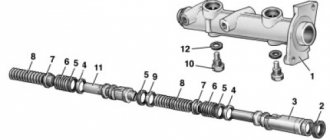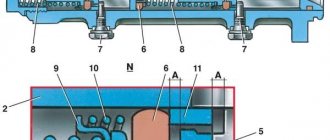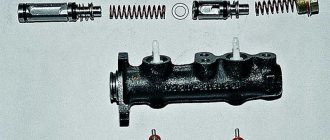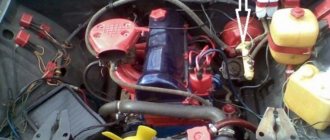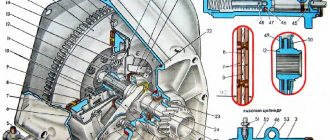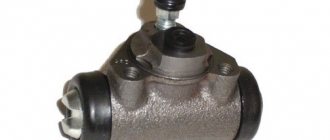The brake master cylinder is the main part of a car's braking system. With its help, the brakes on the car are controlled. The performance of the entire brake system and the safety of both surrounding road users and people in the car itself depend on the condition of this part.
The structure of the VAZ 2107 master brake cylinder includes a body, a reservoir, pistons, and return springs. Due to two working sections, the unit is able to function even if one of them is damaged, but the quality of work may noticeably deteriorate.
We repair the main brake cylinder of a VAZ 2107 with our own hands
The brake master cylinder (MBC) is one of the main elements of the brake system, which determines how safe the vehicle will be used. The driver is obliged to ensure that it is in good condition. If malfunctions are detected, action must be taken immediately. Negligence and delay in repairs can lead to an accident. You can identify faults and repair the VAZ 2107 GTZ yourself.
GTZ: device and purpose
The VAZ 2107 is equipped with a hydraulic brake system consisting of two circuits. When one of the circuits fails, the other continues braking. This improves traffic safety. The master cylinder changes the pressure in the circuits depending on the position of the brake pedal. The GTZ is located on the rear wall of the engine compartment. It can be found under the expansion tank of two sections, which is filled with brake fluid (TF). It looks like an oblong cylinder with holes for connecting brake hoses.
The GTZ housing contains 2 pistons with sealing collars. They are located sequentially one after another. The first one moves due to the influence of the pedal pusher on it and serves the contour of the rear wheels. It forces a second piston to move, which acts on the two brake circuits of the front wheels. Springs that are located between the pistons return them to place when the driver releases the brake pedal.
GTZ performs the following functions:
- distributes the fuel fluid over two brake circuits, which separately serve the front wheels;
- transmits the force of the brake pedal using fluid to the working cylinders (WC);
- directs excess fuel fluid to the expander;
- returns the pedal and rod to their initial position when the driver no longer presses the pedal.
To avoid problems with the brakes during further operation, for replacement you need to buy an original product, preferably from a Tolyatti plant with article number 21013505008.
Diagnostic methods and possible malfunctions of the GTZ
The need to diagnose HTC arises when the following symptoms appear:
- an indicator lights up on the dashboard warning of insufficient brake fluid level;
- in order to brake, you need to press the pedal hard;
- large free play of the pedal, sometimes it falls through;
- when braking sharply, the car moves away from the direction of travel;
- the car slows down, the pedal is depressed as much as possible;
- leakage of fuel fluid from the tank.
First, the area under the gas turbine engine is inspected for drips. They are usually visible on the side member and vacuum booster. If the tank body is intact, you need to remove and repair or replace the GTZ.
To identify malfunctions of the master cylinder without diagnosing other parts of the brake system, you need to perform the following steps:
- Using a wrench, unscrew the brake pipes from their sockets and screw in screws with fine threads in their place;
- plug the outlet openings of the dismantled removed pipes with wooden choppers or pegs;
- Next you need to press the pedal several times.
If the GTZ is working properly, after several presses the chambers will fill with liquid and it will be impossible to press the pedal. On the faulty element, the sealing cuffs allow liquid to pass through, and it flows back into the expander, and the pedal continues to fail. To confirm a malfunction of the turbocharger, you need to unscrew the nuts on the cylinder and move it away from the vacuum booster; the fuel fluid will flow out of the hole.
Sometimes the seals of the second chamber become unusable, while in the first they cope with their function. In this case, when checking, the brake pedal will fall slower. If the gas turbine engine is working properly, the pedal cannot be pressed more than 3 times, since there is nowhere for fluid to flow out of the cylinder.
How to replace the GTZ and change the cuffs
Problems with GTZ are solved in two ways:
- Disassembling and cleaning the device and replacing the seals from the repair kit.
- Complete replacement of the GTZ.
The most reliable option is the second one.
To carry out the work you need to prepare:
- a set of keys;
- special wrench for unscrewing brake pipes;
- screwdriver;
- bulb or syringe;
- narrow nose pliers;
- plastic bottle for liquid;
- rags;
- repair kit or new GTZ.
For the plugs, you need to prepare wooden choppers 6 mm long with a pointed end. After repairs, be sure to bleed the brake circuits. For this procedure, you need to prepare brake fluid, a wrench for unscrewing the fittings on the working cylinders, a wheel wrench, a transparent tube and a bottle. If the cuffs are changed, they must be selected in accordance with the GTZ. Products from different manufacturers may vary. You should buy the original GTZ
Removing and installing the master cylinder
To preserve the fuel fluid from the tank, it is pumped out using a bulb or syringe into a prepared container. Dismantling of the GTZ is carried out according to the following algorithm:
- Having loosened the clamps, disconnect the brake pipes from the GTZ and lower them into a plastic bottle.
- Next, unscrew the three brake hoses. We take them out of the sockets and insert the manufactured plugs.
- Unscrew the nuts securing the GTZ to the amplifier and remove it from the studs. When removing the master cylinder, you need to remove the washers so that they do not fall to the floor.
- If a replacement is carried out, a new one is installed in place of the removed cylinder. Assembly is carried out in the reverse order, carefully tightening the fasteners.
Replacing the repair kit for the main brake cylinder of a VAZ 2107.
Disassembling the GTZ and replacing the cuffs
Before disassembling the unit, you need to drain the remaining fuel fluid and wipe the body with a rag. Further work on replacing the cuffs is a sequence of actions:
- Use a flat-head screwdriver to remove the boot, which is installed inside the cylinder.
- We clamp the GTZ in a vice and loosen the limiting bolts. Unscrew the end cap. We remove it together with the copper washer.
- We take the product out of the vice and completely unscrew the bolts.
- Having laid the cylinder on a flat surface, carefully push out the insides and lay them out in order.
- We clean the part from dirt both inside and outside. We inspect visually. If traces of wear or sinkholes are found, you will have to completely replace the turbocharger.
- Using a screwdriver, remove the rubber seals from the pistons and replace them with new ones. We also change the gaskets.
- Next, we push the parts into the GTZ according to the order.
- Screw in the plug nut and limiting bolts. When pressing on the first piston, check that the springs push the rod back. We install a new boot.
- We install the assembled device in its original place.
After completing the work, we bleed the brakes.
How to properly bleed brake circuits
When performing repairs and replacement of brake system elements, there is a possibility of air getting into it, which will lead to the formation of air locks. Their presence reduces the effectiveness of the brakes. Therefore, it is necessary to bleed the brake circuits according to the instructions. Bleeding begins from the right rear wheel. The process consists of the following steps:
- We place the car on a lifting device.
- We check the fuel fluid level in the tank, it should be at the maximum level. Top up if necessary.
Symptoms of problems
The general technical condition of the car (including the brake system) can be checked using a personal diagnostic adapter - a car scanner. These types of devices are widespread and have a wide price range. We would like to draw your attention to the budget model of Korean production Scan Tool Pro Black Edition.
At a cost of about 2 thousand rubles. This scanner is capable of fully diagnosing your car (engine, gearbox, transmission, abs, srs and much more), which will pay for itself in 1-2 trips to the service station. The adapter is quite easy to use, has Russian-language software and is compatible with most cars produced in 1993. The device will also be useful when buying a used car, as it can show its real mileage and VIN.
The fluid brake system consists of many parts that can become unusable: pipes, wheel cylinders, calipers, drums and pads. Typical signs of a faulty master cylinder:
- After pressing the pedal, the car stops slowly. The reason is that the cuffs of one or two pistons have lost their tightness - they have cracked or “floated”.
- To slow down, you need to press the brake pedal hard. The phenomenon occurs due to swelling of the rubber of the piston seals.
- The brake pedal travel is too short. The fluid inside the cylinder has nowhere to go because the compensation hole is clogged. Another option is that the passage is blocked by a swollen rubber seal.
- A common symptom is pedal failure, the brakes coming on at the end of the stroke. This indicates complete wear of the cuffs; as a result, liquid penetrates behind the piston and rushes into the expansion tank - the cylinder “bypasses.”
- The pads do not release the brake discs and drums and get very hot when driving. Options: one of the pistons is jammed or the bypass hole is clogged.
The listed symptoms of a GTZ malfunction are similar to malfunctions of other elements. Pedal failure also occurs when a large amount of air enters the tubes or loss of fluid in one of the working cylinders. Sluggish deceleration and increased force on the pedal are often caused by a breakdown of the vacuum booster - a cracked membrane or a lack of tightness at the joints of the hose that takes off engine vacuum.
There are signs that clearly indicate the performance of the main hydraulic cylinder and the malfunction of other elements:
- during braking, the car pulls to the side - the problem lies in a certain circuit or wheel;
- jamming of the brake mechanisms of one wheel;
- creaking and squeaking when braking;
- heating the discs and pads on one wheel.
If you eliminate these symptoms, it will become easier to check the brake master cylinder in a garage. This also includes obvious brake fluid leaks and the knocking sound of worn calipers.
How does the brake master cylinder work?
The brake master cylinder is the very heart of the braking system. It changes the pressure in the brake system when you press the brake pedal. It creates increased brake fluid pressure, causing the cylinder pistons to extend and press the pads against the drums and brake discs.
The brake cylinder body contains two pistons with sealing rings that follow each other. The first cylinder is driven by the brake pedal, the second moves due to the movement of the first. Springs ensure that the pistons return to their place after the brake pedal is released.
General structure of the vehicle
The diagram of the brake system of the VAZ 2107 car consists of two main components - the drive mechanism and the brake actuators. Due to the drive mechanism, a braking signal is sent to the actuators, thereby bringing the vehicle to a complete stop or reducing the speed.
Braking is performed by increasing the friction energy of friction units with rotating parts. The brake system of the VAZ 2107 is designed in the traditional version:
- The front part is implemented through the use of disc brakes, which are considered one of the most reliable.
- The rear part is equipped with drum devices, the operation of which is also based on friction force.
The brake system drive can be of different types, but the seven uses exclusively a hydraulic type. The hydraulic drive system uses fluid, which acts as the basis of the VAZ 2107 brake system. Brake fluid has the necessary characteristics and is used as a conductor to transmit force from the brake pedal to the actuators - the pads.
Replacement
Replacing the part yourself is not difficult. To do this, you need to arm yourself with the following set of tools:
- screwdriver;
- keys 10, 13;
- 5 – with a cubic syringe or bulb;
- brake fluid;
- clamps.
If during disassembly you find that the old rubber hoses have become hard, it is recommended to replace them with new ones.
- Remove the belt from the expansion tank and put it aside.
- Using a ten key, unscrew the fastenings of the brake fluid reservoir and open the lid.
- Drain the brake fluid into a container.
- To prevent brake fluid from entering the engine compartment, it is necessary to place a piece of dense material under the cylinder.
- Loosen the clamps on the hoses extending from the tank and remove them.
- Disconnect the three brake pipes and move them a little.
- We unscrew the two nuts securing the cylinder to the amplifier, using a 13mm wrench.
- Remove the brake master cylinder.
- We clean the seat of the spare part from dirt and brake fluid residues.
- Let's move on to a new element. We remove the protective seal and install the oil seal there.
- We insert the new cylinder into place and tighten the nuts.
- We remove the plugs and use a syringe to inject brake fluid into the cylinder cavity until it is completely filled.
- We assemble the remaining elements.
The final stage of repair work will be bleeding the car's brake system.
Removal and repair
To remove, repair and reinstall, you will need a minimum of tools:
- key to 13;
- special wrench for brake pipes;
- flat screwdriver;
- brake master cylinder repair kit;
- brake fluid container;
- syringe;
- brake fluid.
To avoid spilling brake fluid from the reservoir, it must be poured into a prepared container using a syringe. The procedure for removing the cylinder is as follows:
- loosen the rubber hose clamps on the brake cylinder fittings;
- remove the hoses coming from the brake fluid reservoir to the cylinder fittings;
Comments
The GTZ will need to be replaced. Thank you.
- Login to leave comments
Well written. At
Well written. With a certain amount of skill, if you are clever and quickly “close” the fittings of the main pipes when removing, you can do without pumping, or do the bleeding “by gravity.” Caps from GTZ are excellent for closing fittings.
From personal experience, I will say that the VAZ GTZ is complete nonsense at a cost of 80-100 UAH (10-15 $) and a service life of 1-1.5 years. Two main disadvantages: 1. Low-pressure nylon fittings are held in place by crown-springs (bad metal), and with a little effort they pull out of the socket - they were adjusting the valves and accidentally touched the repair belt. I used the kit as a temporary measure. 2. after 20 thousand-30 thousand km the piston in the cylinder begins to bypass. It manifests itself - the pedal is either soft or hard, there is a dependence on the ambient temperature and the intensity of the impact on the pedal, pumping the brakes does not help.
After replacing two VAZ stock units every year, I installed an Italian one (I don’t remember the name) and forgot about the existence of such a part as a GTZ in my car. The main difference from the VAZ one is the metal low-pressure fittings. issue price 25-30$
- Login to leave comments
ATTENTION EVERYONE.
Author I'll kill you))) joke. Because of the author, I postponed everything since the repair was on the street. I am writing to EVERYONE who will do this procedure on the street, instead of having a key for 13 > with a knob. Otherwise, you won’t be able to unscrew the bolt that holds the GTZ to the vacuum seal; there’s very little room for the wrench to fit through.
GTZ malfunctions
Replacing the VAZ-2107 master brake cylinder is required when this part simply fails. You can determine the malfunction of the GTZ in the following ways:
- The red warning light comes on, indicating a problem with the brake mechanism. This lamp comes on when the level in the brake cylinder reservoir drops below normal. In this case, it is important to find out the reason for the decrease in fluid and, if necessary, add it. If the leak occurs due to a malfunction of the turbocharger, it should be replaced.
- Presence of leaks on the GTZ. If, upon opening the hood, you can see signs of a fresh fluid leak on the GTZ, then it’s time to pay attention to repairing the mechanism. It is possible to repair the main brake cylinder of a VAZ-2107, but at the same time you can extend the life of the product for a short time, this is due to the quality of modern spare parts. If the product fails, or more precisely, the cuffs and seals have dried out, then experienced craftsmen recommend replacing the gas turbine unit. Many desperate amateurs strive to find the answer to the question of how to repair the master brake cylinder, but subsequently everything ends with its replacement.
The GTZ for a VAZ-2107 costs about 500 rubles, so it makes no sense to spend time and money to repair it. Let’s find out in more detail how the GTZ is replaced with a VAZ-2107.
Why did it happen so?
Perhaps the automatic requests do not belong to you, but to another user accessing the network from the same IP address as you. You need to enter the characters into the form once, after which we will remember you and be able to distinguish you from other users exiting from this IP. In this case, the page with the captcha will not bother you for quite a long time.
You may have add-ons installed in your browser that can make automatic search requests. In this case, we recommend that you disable them.
It is also possible that your computer is infected with a virus program that is using it to collect information. Maybe you should check your system for viruses.
If you have any problems or would like our support team, please use the feedback form.
A fully operational brake system of a VAZ 2107 car is a key element in ensuring safe movement in a car for both passengers and the driver. Therefore, you should pay special attention to it, and if minor signs of malfunction appear, begin repairs immediately.
The brake master cylinder is one of the main elements of the car's braking system. Basically it can have two faults. The first is the appearance of a fluid leak from the main brake, the second is a decrease in the effectiveness of the brakes, which can be determined by the failure of the pedal or its “softness”. Both of these faults can be eliminated by a not very complicated repair of the main brake; this repair consists of replacing the o-rings and boot, but in some cases the problem can only be solved by replacing the cylinder.
Master brake cylinder
It is not uncommon to discover problems with the master cylinder when checking the condition of the brake assembly.
GTZ
When changing the vacuum seal, it would be logical to study the current state of the gas turbine engine and, if necessary, replace it.
Many are trying to repair the GTZ. But in practice, this only brings a temporary effect, plus you have to constantly worry whether the node will fail at the most inopportune moment. The best solution is replacement.
The replacement procedure itself is as follows.
- Disconnect the negative terminal from the battery.
- Disconnect the wire block from the fuel oil level sensor. It is located in the tank and is built directly into the lid.
- Use a special wrench for brake pipes to loosen their tension. There is no need to unscrew it completely.
- Unscrew the pair of nuts that secure the GTZ to the vacuum chamber. Only now can the brake pipes be completely unscrewed.
- Remove the cylinder from the studs.
- If necessary, remove the brake fluid reservoir itself at the same time. To do this, you need to carefully rock the tank and remove the leg from the bushing.
- Assess the condition of the removed cylinder. Also be sure to check for any defects on the tank. If there are any, be sure to replace the brake fluid reservoir with a new one.
- Armed with a new GTZ, put it in place and tighten the nuts. Fasteners can be fully tightened immediately.
- Install the reservoir and fill it with brake fluid to the maximum mark.
- Now a very important step is to extract air from the cylinder. To do this, you need to close the holes in the front brake pipes with your fingers. At the same time, your assistant should gently, but not sharply, press the brake pedal. This will create pressure in the system. Continue this manipulation until you feel liquid coming out of the holes.
- As soon as the liquid flows, put on the tubes, install and fix them in place. In this case, the brake pedal cannot be released.
- By analogy, the rear tubes are connected. When they are installed in place, there must be pressure in the system, that is, the brake pedal is pressed to the floor.
Replacing brake cylinders, procedure
So, before you begin this procedure, you first need to completely remove the caliper with the cylinders. After this, it is advisable to lubricate the cylinder seating areas with penetrating lubricant. Then take the key and unscrew the brake connecting pipes. It all looks roughly as I showed in the picture:
After this, take a screwdriver and press on a special metal clamp, which is located in the slot of the caliper on the side. You can look at it in more detail here:
And at the moment when the latch is pressed, with light blows of a hammer we knock out the brake cylinder from the caliper seat.
In this case, I was unable to unscrew the brake pipes, since they had not been unscrewed for years and were eaten away by rust. So I decided to simply cut the tubes with pliers and then replace them with new ones.
All is ready. We carry out replacement in the reverse order. The price of new brake cylinders for a VAZ 2106 is about 1,500 rubles for a set of two pieces along with a caliper.
Symptoms of a GTZ malfunction
The first signs of a brake malfunction, and sometimes the only reason why replacing the master brake cylinder of a VAZ 2107 is necessary, is a signal that is simple and understandable to any teapot - a red lamp on the instrument panel. It will tell a careless driver that the level of brake fluid in the reservoir is critically low. There is no need to panic right away. Perhaps the fluid began to drain a long time ago, and if you fill the tank to the MAX mark, the car will be able to last for some time without repair. However, if the fluid level drops again, then repairs are necessary.
Diagnostics of the brake system is simple and straightforward - if there are leaks on the main cylinder itself, it needs to be replaced or repaired. Its price is about 500 rubles assembled, regardless of the manufacturer, and can fluctuate within hundreds, depending on the greed of the seller. The most desperate car enthusiasts disassemble the master brake cylinder and try to change the cuffs and seals. Often this leads to the expected result, but only if you managed to buy a good complete repair kit with all seals, gaskets and cuffs.
Replacing the master brake cylinder
Replacing the GTZ on VAZ classic cars (2101-07) is not difficult; you can do this work yourself. To perform such an operation you will need the following tool:
- 10mm wrench (or special bleeder wrench);
- Phillips screwdriver;
- combination wrench for 13 (you can additionally use a head with a knob and a ratchet for convenience).
It is not necessary to use a pit or a lift to perform the work; replacement can be done outside in dry weather or in the garage. The work should be performed in the following sequence:
- unscrew the three brake pipes from the bottom of the device (key for ten);
- loosen the clamps of the two hoses (at the bottom of the GTZ), pull off the hoses;
- unscrew the two nuts securing the GTZ to the vacuum booster (you need a 13mm wrench or a socket with a wrench);
- We dismantle the part, install the new gas turbine unit in place, and reassemble it.
After the operation, you should add fluid to the vehicle reservoir, then be sure to bleed the brakes well.
Replacing brake cylinder 2114
The work of replacing the GTZ on VAZ 2108-15 models is carried out approximately the same way, there are only some design differences.
We make the replacement as follows (using the example of the VAZ-2114):
- Unscrew the four tubes on the sides (two on the left and two on the right). It is better to use a special pipe wrench; you can roll up the edges of the nuts with an open-end wrench;
What is GTZ?
The main brake cylinder consists of a metal housing, which has holes for the supply of brake fluid (BF), a pedal rod and an expansion tank, which is located at the top. And also 2-3 pistons with seals and return springs, guide bushings and an end cap with a gasket.
The expansion tank is necessary to maintain the reserve, as well as excess fuel fluid. Inside, the GTZ has 2 cylinders with separate pistons located on the same axis. The edge of the metal case is tightly closed with a screw plug, and on the opposite side there is a flange for attaching to the vacuum booster. The brake pedal is attached to the first piston by means of a rod. The brake circuits of the front and rear wheels in the form of tubes are attached to the lower holes of the GTZ housing.
